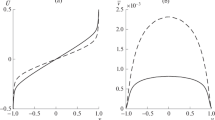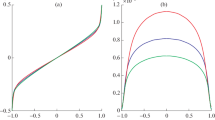Abstract
Optimal disturbances of a turbulent stably stratified plane Couette flow in a wide range of Reynolds and Richardson numbers are studied. These disturbances are computed based on a simplified system of equations in which turbulent Reynolds stresses and heat fluxes are approximated by isotropic viscosity and diffusivity with the coefficients obtained from results of direct numerical simulation. Three types of disturbances are considered: large-scale streamwise-elongated rolls converting into streamwise streaks; large-scale vortical structures, inclined in the vertical plane, changing the inclination to the opposite in process of their evolution; near-wall rolls converting into streaks. Large-scale rolls and streaks predominate at neutral or weakly stable stratification while the inclined structures begin to dominate at moderately stable stratification. Near-wall rolls and streaks appear at any stratification and their spanwise size in wall length units does not depend on the values of Reynolds and Richardson numbers. It is shown that the development of inclined optimal disturbances is due to the coupled action of the lift-up effect and the inviscid Orr mechanism. The energetics of the optimal disturbances is discussed. It is shown that inclined optimal disturbances dissipate rapidly after reaching maximum energy amplification.














Similar content being viewed by others
Data availibility
The results of DNS used during the current study are available from E.V. Mortikov (evgeny.mortikov@gmail.com) on reasonable request.
References
Adrian RJ (2007) Hairpin vortex organization in wall turbulence. Phys Fluids 19(4):041,301
Bakewell HP Jr, Lumley JL (1967) Viscous sublayer and adjacent wall region in turbulent pipe flow. Phys Fluids 10(9):1880–1889
Boiko AV, Dovgal AV, Grek GR, Kozlov VV (2011) Physics of transitional shear flows: instability and laminar–turbulent transition in incompressible near-wall shear layers. Springer Science & Business Media, Berlin
Brandt L (2014) The lift-up effect: the linear mechanism behind transition and turbulence in shear flows. Eur J Mech B/Fluids 47:80–96
Businger JA, Wyngaard JC, Izumi Y, Bradley EF (1971) Flux-profile relationships in the atmospheric surface layer. J Atmos Sci 28(2):181–189
Butler KM, Farrell BF (1992) Three-dimensional optimal perturbations in viscous shear flow. Phys Fluids 4(8):1637–1650
Canuto C, Hussaini MY, Quarteroni A, Zang TA (2007) Spectral methods: fundamentals in single domains. Springer Science & Business Media, Berlin
Cossu C, Hwang Y (2017) Self-sustaining processes at all scales in wall-bounded turbulent shear flows. Phil Trans R Soc 375(2089):20160,088
Cossu C, Pujals G, Depardon S (2009) Optimal transient growth and very large-scale structures in turbulent boundary layers. J Fluid Mech 619:79–94
del Alamo JC, Jimenez J (2006) Linear energy amplification in turbulent channels. J Fluid Mech 559:205–213
Ellingsen T, Palm E (1975) Stability of linear flow. Phys Fluids 18(4):487–488
Foster RC (1997) Structure and energetics of optimal ekman layer perturbations. J Fluid Mech 333:97–123
Glazunov AV (2014) Numerical simulation of stably stratified turbulent flows over flat and urban surfaces. Izv Atmos Ocean Phys 50(3):236–245
Glazunov AV, Mortikov EV, Barskov KV, Kadantsev EV, Zilitinkevich SS (2019) Layered structure of stably stratified turbulent shear flows. Izv Atmos Ocean Phys 55(4):312–323
Hamilton JM, Kim J, Waleffe F (1995) Regeneration mechanisms of near-wall turbulence structures. J Fluid Mech 287(1):317–348
Homemma S, Adrian R (2003) Packet structure of surface eddies in the atmospheric boundary layer. Boundary-Layer Meteorol 106(1):147–170
Hwang Y, Cossu C (2009) Optimal amplification of large-scale structures in plane turbulent couette flow. In: Sixth international symposium on turbulence and shear flow phenomena, pp 159–164
Hwang Y, Cossu C (2010) Amplification of coherent streaks in the turbulent couette flow: an input-output analysis at low reynolds number. J Fluid Mech 643:333–348
Jiao Y, Hwang Y, Chernyshenko SI (2021) The orr mechanism in transition of parallel shear flow. Phys Rev Fluids 6(2):023–902
Kaminski AK, Caulfield CP, Taylor JR (2014) Transient growth in strongly stratified shear layers. J Fluid Mech 758:R4-1-R4-12
Kaminski AK, Caulfield CP, Taylor JR (2017) Nonlinear evolution of linear optimal perturbations of strongly stratified shear layers. J Fluid Mech 825:213–244
Kitoh O, Nakabyashi K, Nishimura F (2005) Experimental study on mean velocity and turbulence characteristics of plane couette flow: low-reynolds-number effects and large longitudinal vortical structure. J Fluid Mech 539:199–227
Kline SJ, Reynolds WC, Schraub FA, Runstadler PW (1967) The structure of turbulent boundary layers. J Fluid Mech 30(4):741–773
Komminaho J, Lundbladh A, Johansson AV (1996) Very large structures in plane turbulent couette flow. J Fluid Mech 320:259–285
Landahl MT (1980) A note on an algebraic instability of inviscid parallel shear flows. J Fluid Mech 98(2):243–251
Lee M, Moser D (2018) Extreme-scale motions in turbulent plane couette flows. J Fluid Mech 842:128–145
Lee MJ, Kim J (1991) The structure of turbulence in a simulated plane couette flow. Eighth Symp. Turbulent Shear Flows 5:5.3.1-5.3.6
Lorenz EN (1955) Available potential energy and the maintenance of the general circulation. Tellus 7(2):157–167
Malkus WVR (1956) Outline of a theory of turbulent shear flow. J Fluid Mech 1(5):521–539
McKeon BJ (2017) The engine behind (wall) turbulence: perspectives on scale interactions. J Fluid Mech 817:1–86
Moin P, Kim J (1982) Numerical investigation of turbulent channel flow. J Fluid Mech 118:341–377
Monin AS, Obukhov AM (1954) Basic laws of turbulent mixing in the surface layer of the atmosphere. Contrib Geophys Inst Acad Sci USSR 151(163):e187
Mortikov EV, Glazunov AV, Lykosov VN (2019) Numerical study of plane couette flow: turbulence statistics and the structure of pressure-strain correlations. Russ J Numer Anal Math Model 34(2):119–132
Nechepurenko YM (2012) On the dimension reduction of linear differential-algebraic control systems. Doklady Math 86(1):457–459
Nechepurenko YM, Sadkane M (2011) A low-rank approximation for computing the matrix exponential norm. SIAM J Matr Anal Appl 32(2):349–363
Obukhov AM (1971) Turbulence in an atmosphere with a non-uniform temperature. Boundary-Layer Meteorol 2(1):7–29
Orr WMF (1907) The stability or instability of the steady motions of a perfect liquid and of a viscous liquid. part i: A perfect liquid. In: Proceedings of the Royal Irish Academy. Section A: Mathematical and Physical Sciences, vol 27, pp 9–68
Petenko I, Argentini S, Casasanta G, Genthon C, Kallistratova M (2019) Stable surface-based turbulent layer during the polar winter at dome c, antarctica: Sodar and in situ observations. Boundary-Layer Meteorol 171(1):101–128
Pujals G, García-Villalba M, Cossu C, Depardon S (2009) A note on optimal transient growth in turbulent channel flows. Phys Fluids 21(1):015–109
Rawat S, Cossu C, Hwang Y, Rincon F (2015) On the self-sustained nature of large-scale motions in turbulent couette flow. J Fluid Mech 782:515–540
Reddy SC, Henningson DS (1993) Energy growth in viscous channel flows. J Fluid Mech 252:209–238
Reynolds WC, Hussain AKMF (1972) The mechanics of an organized wave in turbulent shear flow. part 3. theoretical models and comparisons with experiments. J Fluid Mech 54(2):263–288
Schmid PJ (2007) Nonmodal stability theory. Annu Rev Fluid Mech 39:129–162
Schmid PJ, Henningson DS (1994) Optimal energy density growth in hagen-poiseuille flow. J Fluid Mech 277:197–225
Schmid PJ, Henningson DS (2001) Stability and Transition in Shear Flows. Springer-Verlag, New York
Smith CR, Metzler SP (1983) The characteristics of low-speed streaks in the near-wall region of a turbulent boundary layer. J Fluid Mech 129(1):27–54
Sullivan PP, Weil JC, Patton EG, Jonker HJ, Mironov DV (2016) Turbulent winds and temperature fronts in large-eddy simulations of the stable atmospheric boundary layer. J Atmos Sci 73(4):1815–1840
Waleffe F (1997) On a self-sustaining process in shear flows. Phys Fluids 9(4):883–900
Zasko GV, Nechepurenko YM (2021) Spectral analysis of the optimal disturbances of stratified turbulent couette flow. Comp Math Math Phys 61(1):136–149
Zasko GV, Glazunov AV, Mortikov EV, Nechepurenko YM (2020) Large-scale structures in stratified turbulent couette flow and optimal disturbances. Russ J Numer Anal Math Model 35(1):37–53
Zilitinkevich SS, Elperin T, Kleeorin N, Rogachevskii I (2007) Energy-and flux-budget (efb) turbulence closure model for stably stratified flows. part i: Steady-state, homogeneous regimes. In: Atmospheric Boundary Layers, Springer, pp 11–35
Zilitinkevich SS, Elperin T, Kleeorin N, Rogachevskii I, Esau I (2013) A hierarchy of energy-and flux-budget (efb) turbulence closure models for stably-stratified geophysical flows. Boundary-Layer Meteorol 146(3):341–373
Acknowledgements
Numerical analysis of the optimal disturbances and mathematical justification of the results were supported by Russian Science Foundation (Grant No. 17-71-20149). Direct numerical simulation and physical justification of the results were supported by Russian Foundation for Basic Research (Grant No. 20-05-00776). Direct numerical simulations were carried out using the equipment of the shared research facilities of HPC computing resources at Lomonosov Moscow State University. We express our gratitude to the two anonymous reviewers for their helpful comments and suggestions.
Author information
Authors and Affiliations
Corresponding author
Ethics declarations
Conflicts of interest
Authors declare no conflict of interest.
Additional information
Publisher's Note
Springer Nature remains neutral with regard to jurisdictional claims in published maps and institutional affiliations.
Rights and permissions
Springer Nature or its licensor holds exclusive rights to this article under a publishing agreement with the author(s) or other rightsholder(s); author self-archiving of the accepted manuscript version of this article is solely governed by the terms of such publishing agreement and applicable law.
About this article
Cite this article
Zasko, G.V., Glazunov, A.V., Mortikov, E.V. et al. Optimal Energy Growth in Stably Stratified Turbulent Couette Flow. Boundary-Layer Meteorol 187, 395–421 (2023). https://doi.org/10.1007/s10546-022-00744-3
Received:
Accepted:
Published:
Issue Date:
DOI: https://doi.org/10.1007/s10546-022-00744-3




